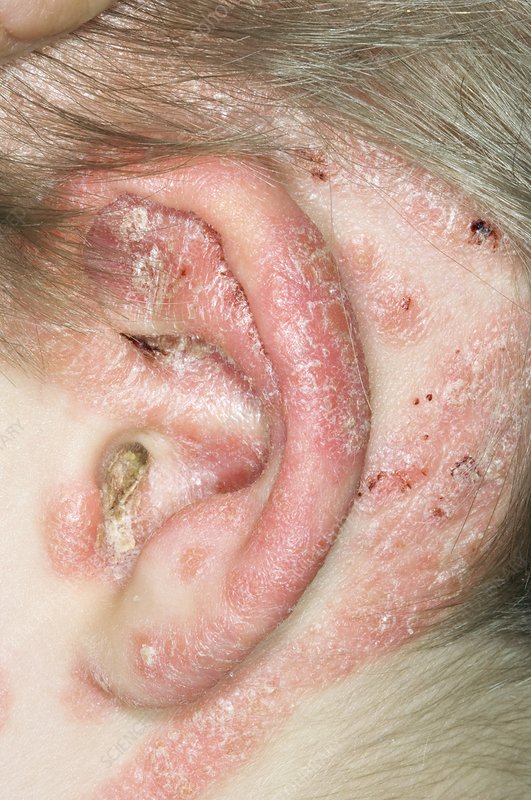What are the symptoms of psoriasis in the ears?
Psoriasis in the ears can cause several specific symptoms, including:
- Red, Scaly Patches: Plaques of thickened, red skin with silvery scales may develop on the outer ear, including the ear canal and behind the ears.
- Itching and Discomfort: The affected areas may be itchy and uncomfortable, leading to a desire to scratch or rub the ears.
- Dryness and Flakiness: The skin in the ears may become dry and flaky, with visible flakes or peeling skin.
- Pain or Tenderness: In some cases, the skin may become sore or tender, especially if scratched or irritated.
- Ear Canal Issues: Psoriasis can cause scaling and inflammation inside the ear canal, which may lead to a sensation of fullness or even hearing problems if the ear canal becomes obstructed.
These symptoms can vary in severity and may impact both the visible parts of the ear and the ear canal.
What are the causes of psoriasis in the ears?
Psoriasis in the ears is caused by the same underlying factors that contribute to psoriasis elsewhere on the body. These include:
- Genetic Factors: A family history of psoriasis or other autoimmune conditions can increase the likelihood of developing psoriasis in the ears.
- Immune System Dysfunction: Psoriasis is an autoimmune disorder where the immune system mistakenly attacks healthy skin cells, leading to the rapid production of skin cells and the formation of scaly plaques.
- Environmental Triggers: Various environmental factors, such as stress, infections, skin injuries, and certain medications, can trigger or exacerbate psoriasis. Cold weather and dryness might also contribute to flare-ups in the ears.
- Skin Irritation: Frequent irritation or injury to the skin, including the skin around and inside the ears, can trigger or worsen psoriasis. This may include scratching or the use of irritating ear products.
- Infections: Certain infections, particularly those affecting the skin or throat, can act as triggers for psoriasis flare-ups.
These factors can interact in complex ways, contributing to the development and exacerbation of psoriasis in the ears.
What is the treatment for psoriasis in the ears?
Treating psoriasis in the ears involves a combination of approaches to manage symptoms and reduce flare-ups. These may include:
- Topical Treatments: Corticosteroid creams or ointments are commonly used to reduce inflammation and itching. Other topical treatments, such as calcipotriene (a vitamin D derivative) or tar-based products, may also be prescribed.
- Moisturizers: Applying emollients or moisturizers can help keep the skin in and around the ears hydrated, reducing dryness and scaling.
- Medicated Shampoos: If psoriasis affects the scalp and the surrounding ear areas, medicated shampoos containing tar or salicylic acid can help manage symptoms.
- Avoiding Irritants: It’s important to avoid using harsh ear products or frequent cleaning that may irritate the skin further. Gentle ear care practices are recommended.
- Systemic Treatments: In more severe cases, oral or injectable medications such as methotrexate, cyclosporine, or biologics may be prescribed to manage the condition systemically.
- Phototherapy: Light therapy, which involves exposing the skin to ultraviolet light under medical supervision, can be effective for treating psoriasis.
- Lifestyle Adjustments: Stress management, maintaining a healthy diet, and avoiding known triggers can help in controlling flare-ups.
Consulting with a dermatologist is essential to tailor the treatment plan to your specific needs and to monitor the effectiveness of the chosen therapies.

Leave a Reply
You must be logged in to post a comment.